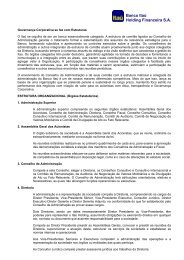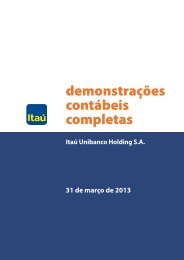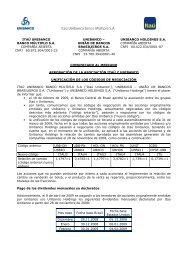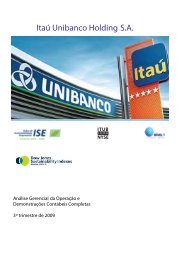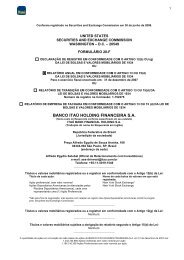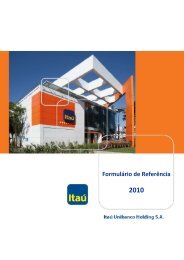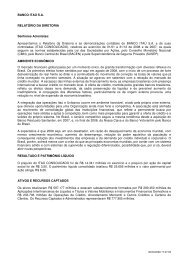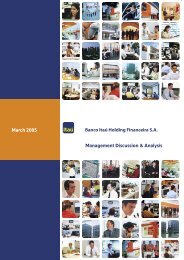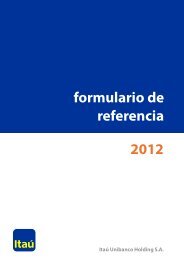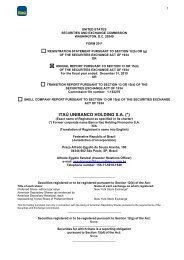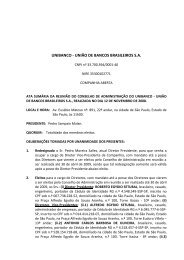Relationships - Banco Itaú
Relationships - Banco Itaú
Relationships - Banco Itaú
Create successful ePaper yourself
Turn your PDF publications into a flip-book with our unique Google optimized e-Paper software.
Corporate Governance<br />
• Governance Structures<br />
• Transparency in Reporting<br />
• Socio-environmental Risk<br />
• Crisis Management<br />
• Ethics Management<br />
Socio-environmental analysis categories, by risk potential<br />
A-<br />
B-<br />
A+<br />
B+<br />
C<br />
High potential for significant socio-environmental impact.<br />
Low socio-environmental risk management capacity<br />
Medium potential for significant socio-environmental impact<br />
Low socio-environmental risk management capacity<br />
High potential for significant environmental impact<br />
Company capable of managing socio-environmental risks<br />
Medium potential for significant socio-environmental impact<br />
Company capable of managing socio-environmental risks<br />
Low potential for significant socio-environmental impact<br />
High<br />
Medium<br />
Low<br />
Environmental Risk Policy<br />
In addition to commitments taken on by<br />
joining the Equator Principles in 2007, we<br />
have established a Corporate Credit Socioenvironmental<br />
Risk Policy. This initiative<br />
reaffirms our strategy of integrating social<br />
and environmental criteria into the credit<br />
decision-making process. In applying the<br />
policy we seek to evaluate the socioenvironmental<br />
risk of project funding and<br />
of the customers’ activities, in this case by<br />
analyzing their socio-environmental risk<br />
management capability.<br />
In 2009, during the integration activities,<br />
we continued to consolidate our Corporate<br />
Credit Socio-environmental Risk Policy.<br />
This process began in December 2007<br />
with a unique socio-environmental<br />
risk assessment methodology, whose<br />
unique scope was the result of extensive<br />
consultation with some of our strategic<br />
relationship groups, similar to international<br />
standard AA1000. The policy’s main<br />
objectives are:<br />
• establish guidelines and tools to assess<br />
socio-environmental risks in corporate credit<br />
risk analysis;<br />
• give internal support to sustainable<br />
development actions and programs and<br />
provide guidelines for training professionals<br />
from the business and corporate credit<br />
areas; and<br />
• encourage corporate clients to improve their<br />
socio-environmental practices.<br />
Currently, <strong>Itaú</strong> Unibanco and <strong>Itaú</strong> BBA also<br />
develop specific guidelines to evaluate certain<br />
sectors. One example is the housing sector,<br />
which already has a sector-specific socioenvironmental<br />
policy, established in late 2009<br />
for the mortgage loan review process for<br />
commercial banking customers (read more<br />
about the subject in the Business/Mortgage<br />
section of this Report).<br />
The Policy in Practice<br />
The Corporate Credit Socio-environmental Risk<br />
Policy began in 2007, and was expected to be<br />
implemented within two years to provide socioenvironmental<br />
risk analysis of commercial loans<br />
of over R$5 million. This objective was achieved<br />
in 2009, and the socio-environmental risk analysis<br />
process and tools for commercial loans are now in<br />
operation. The procedures include two separate<br />
stages: (1) classification of a sector socioenvironmental<br />
risk (High, Medium and Low<br />
risk - A, B, C); and (2) individualized analysis of<br />
those clients in high or medium (A and B) socioenvironmental<br />
risk classes, involving financing<br />
of $5 million or more.<br />
The continuous improvement of the<br />
application process for this policy is a strategic<br />
concern at <strong>Itaú</strong> Unibanco. We have made<br />
investments in organizing the structure of the<br />
area in charge and in technology, with a view<br />
to improving the analysis tools to make the<br />
process faster and easier.<br />
In 2009 we analyzed middle market customers<br />
(medium-sized companies) in the portfolio,<br />
using the criteria set by the policy. Every<br />
customer involved with financing equal to<br />
or higher than R$5 million received a sector<br />
socio-environmental risk classification of A,<br />
B or C, while eligible candidates (classes A<br />
and B), which represent 60% of this group,<br />
underwent the review process. During the<br />
year, 2,046 socio-environmental technical<br />
statements were issued – 1,933 in favour and<br />
113 against. Of these, 13 were considered<br />
favourable after clarifications provided<br />
40 <strong>Itaú</strong> Unibanco Holding S.A.



